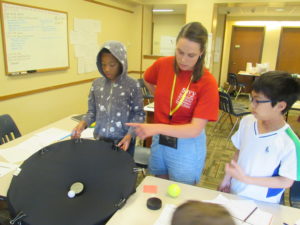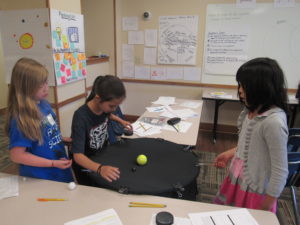Summer SAVY 2019: Session 2, Day 3 – Stories and the Structure of the Universe (Rising 5th/6th)
Posted by hallep on Wednesday, June 19, 2019 in Grade 5, Grade 6, SAVY.
What an exciting day we’ve had!
We started the day with a quick recap of Newton’s laws and then turned our attention to Albert Einstein, who build on Isaac Newton’s ideas and even changed them. Our comparison raised the question of whether Newton was wrong in his ideas. We reached a consensus that Newton was not wrong exactly, even though his ideas hold true better on our planet than in outer space (another paradox!).

This discussion of two very famous scientists and how ideas can change over time unfolded into a discussion of why “history” leaves so many people out (such as women, African-Americans, and people who may not be “first” to do or discover something but who make important contributions by building on others’ ideas). History is a kind of story we tell from generation to generation, and history is also a way we structure our understanding of the world, so we took some time in our class about story and structure to consider this important question! We considered the roles of injustice, opportunity, and privilege in how history has unfolded and how “history” as an area of study is often structured. Students pointed out that famous people are not necessarily good people, that people in more ancient times are also often not discussed, and that the film
Hidden Figures does a good job of telling the important stories of African-American women’s contributions to the space program.

We then turned our attention back to the theory of general relativity and conducted experiments with a model that helped us visualize the “fabric” of the space-time continuum. Ask your SAVY student about this interesting activity! Students experimented with different sized “stars” and orbiters to draw conclusions about how the curvature of spacetime impacts gravity and orbits and how mass, distance, and gravity impact orbit. Students then had opportunity to design their own research questions to investigate using the simulation. After the experiment, we returned to the concept of structure and added important insights and observations to our collaborative concept map.
We finished another chapter from A Wrinkle In Time and discussed characters’ strengths and weaknesses, observing that a character’s weakness can also be a strength–an interesting paradox to note. We then considered the genre of science fiction and its relationship to science and art. After an interesting conversation about the nature of time, students wrote poems about time, creatively incorporating sense-based similes and metaphors to convey something about the nature of time. The poems that emerged were humorous, intriguing, and insightful! We look forward to sharing them at our open house!
After reading Ray Bradbury’s short story “A Sound of Thunder,” a gripping tale of time travel which we will further consider tomorrow, students began planning their culminating projects for the week. Everyone had important decisions to make about project options and areas of focus, and structuring available time to complete projects successfully will be key! I’m looking forward to a fabulous rest of the week!
 This discussion of two very famous scientists and how ideas can change over time unfolded into a discussion of why “history” leaves so many people out (such as women, African-Americans, and people who may not be “first” to do or discover something but who make important contributions by building on others’ ideas). History is a kind of story we tell from generation to generation, and history is also a way we structure our understanding of the world, so we took some time in our class about story and structure to consider this important question! We considered the roles of injustice, opportunity, and privilege in how history has unfolded and how “history” as an area of study is often structured. Students pointed out that famous people are not necessarily good people, that people in more ancient times are also often not discussed, and that the film Hidden Figures does a good job of telling the important stories of African-American women’s contributions to the space program.
This discussion of two very famous scientists and how ideas can change over time unfolded into a discussion of why “history” leaves so many people out (such as women, African-Americans, and people who may not be “first” to do or discover something but who make important contributions by building on others’ ideas). History is a kind of story we tell from generation to generation, and history is also a way we structure our understanding of the world, so we took some time in our class about story and structure to consider this important question! We considered the roles of injustice, opportunity, and privilege in how history has unfolded and how “history” as an area of study is often structured. Students pointed out that famous people are not necessarily good people, that people in more ancient times are also often not discussed, and that the film Hidden Figures does a good job of telling the important stories of African-American women’s contributions to the space program.
Leave a Response